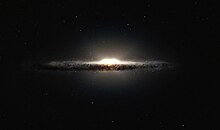
Stellar archaeology is the study of the early history of the universe, based on its early composition. By examining the chemical abundances of the earliest stars in the universe: metal-poor, Population II stars; insights are gained into their earlier, metal-free, Population III progenitors. This sheds light on such processes as galaxy formation and evolution, early star formation, nucleosynthesis in stars and supernovae, and the formation processes of the galactic halo. The field has already discovered that the Milky Way cannibalizes surrounding dwarf galaxies, giving it a youthful appearance.
References
- "Stellar Archaeology Traces Milky Way's History". HubbleSite. 30 May 2012. Retrieved 11 February 2014.
- Frebel, A. (2010), "Stellar archaeology: Exploring the Universe with metal-poor stars (Ludwig Biermann Award Lecture 2009)", Astronomische Nachrichten, 331 (5): 474–488, arXiv:1006.2419, Bibcode:2010AN....331..474F, doi:10.1002/asna.201011362, S2CID 119096730
- Nerlich, Steve (26 June 2010). "Astronomy Without A Telescope – Stellar Archaeology". Universe Today. Retrieved 11 February 2014.
- Brainard, Curtis (10 February 2014). "The Archaeology of the Stars". New York Times. Retrieved 11 February 2014.